Attached files
| file | filename |
|---|---|
| EX-99.2 - EX-99.2 - Nabriva Therapeutics plc | a17-22173_1ex99d2.htm |
| 8-K - 8-K - Nabriva Therapeutics plc | a17-22173_18k.htm |
Lefamulin Evaluation Against Pneumonia (LEAP 1) Phase 3 Topline Results September 18, 2017
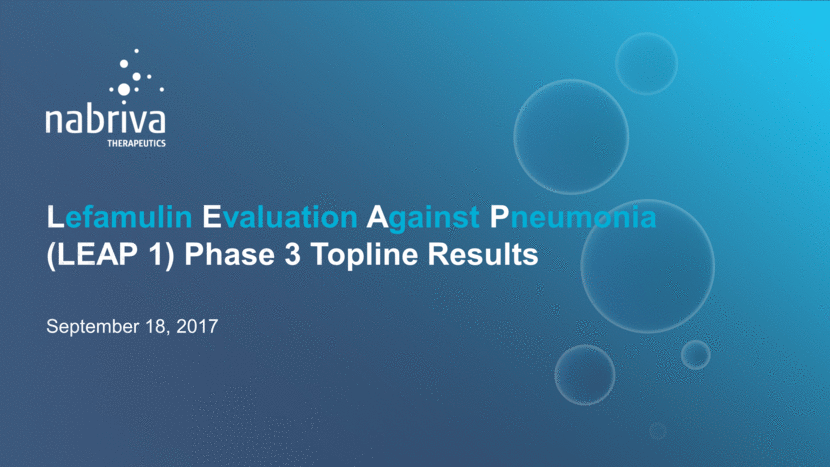
Any statements in this presentation about future expectations, plans and prospects for Nabriva, including but not limited to statements about the development of Nabriva’s product candidates, such as plans for the design, conduct and timelines of Nabriva’s ongoing Phase 3 clinical trial of lefamulin for CABP, the clinical utility of lefamulin for CABP and Nabriva’s plans for filing of regulatory approvals and efforts to bring lefamulin to market, the development of lefamulin for additional indications, the development of additional formulations of lefamulin, plans to pursue research and development of other product candidates, the sufficiency of Nabriva’s existing cash resources and other statements containing the words “anticipate,” “believe,” “estimate,” “expect,” “intend,” “may,” “plan,” “predict,” “project,” “target,” “potential,” “likely,” “will,” “would,” “could,” “should,” “continue,” and similar expressions, constitute forward-looking statements within the meaning of The Private Securities Litigation Reform Act of 1995. Actual results may differ materially from those indicated by such forward-looking statements as a result of various important factors, including: the uncertainties inherent in the initiation and conduct of clinical trials, availability and timing of data from clinical trials, whether results of early clinical trials or trials in different disease indications will be indicative of the results of ongoing or future trials, whether results of Nabriva’s first Phase 3 clinical trial of lefamulin will be indicative of the results for its second Phase 3 clinical trial of lefamulin, uncertainties associated with regulatory review of clinical trials and applications for marketing approvals, the availability or commercial potential of product candidates including lefamulin for use as a first-line empiric monotherapy for the treatment of moderate to severe CABP, the sufficiency of cash resources and need for additional financing and such other important factors as are set forth under the caption “Risk Factors” in Nabriva’s annual and quarterly reports on file with the U.S. Securities and Exchange Commission. In addition, the forward-looking statements included in this press release represent Nabriva’s views as of the date of this release. Nabriva anticipates that subsequent events and developments will cause its views to change. However, while Nabriva may elect to update these forward-looking statements at some point in the future, it specifically disclaims any obligation to do so. These forward-looking statements should not be relied upon as representing Nabriva’s views as of any date subsequent to the date of this presentation. Safe Harbor and Disclaimer
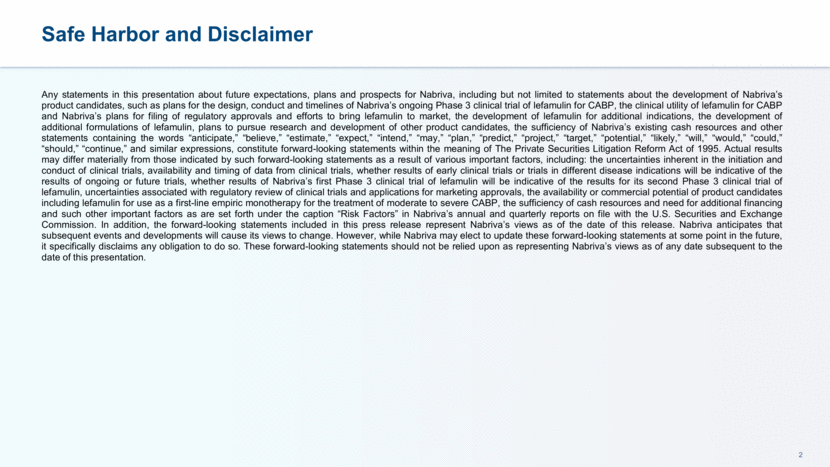
Significant medical need for a new treatment of CABP due to increasing bacterial resistance and high morbidity and mortality Lefamulin in two global, pivotal Phase 3 trials for moderate-to-severe CABP with topline data received in September 2017 and expected for LEAP 2 in the spring of 2018 Investing in pre-commercial activities to maximize U.S. commercial potential and evaluating ex-U.S. partner(s) 2017- A Transformational Year for Nabriva Building a Fully Integrated Anti-Infectives Company Expert team advancing pleuromutilins, a new class of antibiotics, for systemic (IV and oral) use in humans
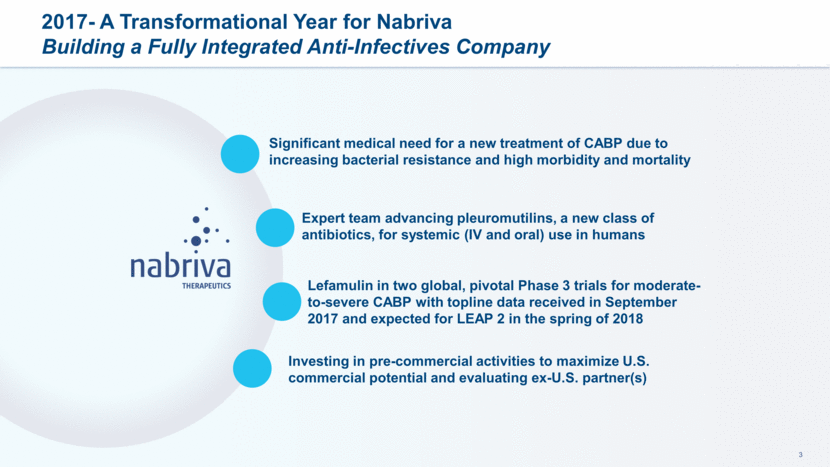
Pneumonia: A Leading Cause of Morbidity, Mortality and Cost 5-6MM Approximately CABP cases annually Mortality rate for admitted patients Mortality rate for those who require admission to ICU Leading cause of death ~15% ~25 - 30% ~8th Sources: File TM.J Manag Care Pharm.2009;15(2 Suppl):S5-S11 - Fingar K, Washington R. Trends in hospital readmissions for four high-volume conditions, 2009-2013: Statistical Brief #196. Healthcare Cost and Utilization Project (HCUP) Statistical Briefs. Rockville, MD: Agency for Healthcare Research and Quality; November 2015. http//www.hcup-us.ahrq.gov/reports/statbriefs/sb196-Readmissions-Trends-High-Volume-Conditions.pdf. Accessed February 23, 2016. File TM Jr, Marrie TJ. Burden of community-acquired pneumonia in North American adults. Postgrad Med. 2010;122:130–41. Fingar K, Washington R. Trends in Hospital Readmissions for Four High-Volume Conditions, 2009-2013: Statistical Brief #196. Healthcare Cost and Utilization project (HCUP) Statistical briefs. Rockville, MD: Agency for Healthcare Research and Quality; November 2015 ~$17B Direct hospitalization costs of CAP In 2013, the pneumonia diagnosis was ranked #1 for total hospitalizations and #3 for readmission rate
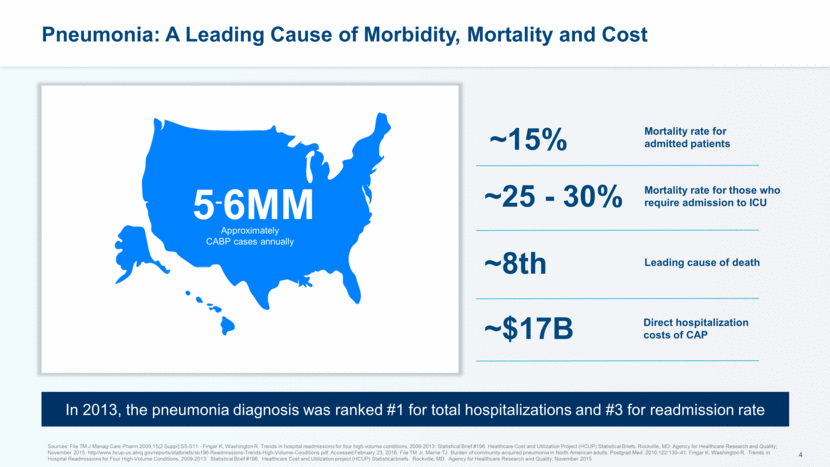
Lefamulin A site P site PTC of the 23S rRNA of the large ribosomal subunit Pleuromutilins Represent a New Class of Antibiotics for Systemic Human Use Lefamulin: Discovered and developed by Nabriva Therapeutics Novel mechanism of action with four distinctive binding sites in highly conserved core of the ribosomal peptidyl transferase center (PTC) Targeted anti-bacterial spectrum against respiratory pathogens (Gram-positive, Gram-negative and atypical bacteria) Minimal effect on off-target GI flora such as B. fragilis, E. coli and E. faecalis Low propensity for development of bacterial resistance and lack of cross-resistance with other antibiotic classes, based on in vitro studies lefamulin
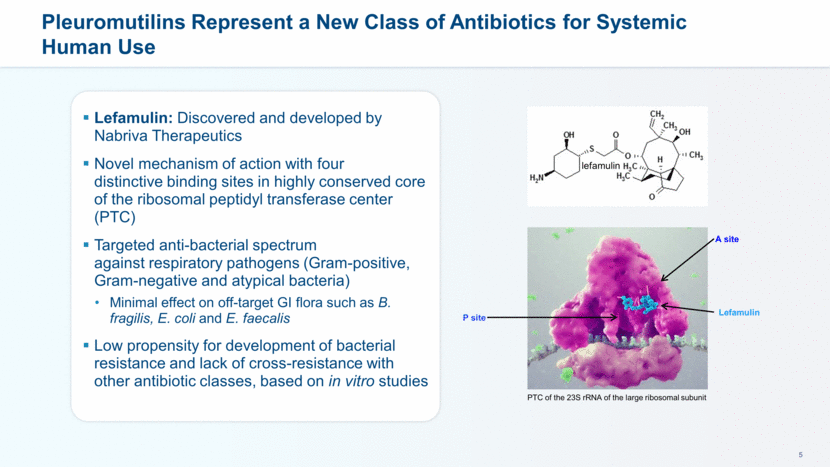
LEAP 1 Trial Design and Demographics

LEAP 1 Phase 3 Trial Design IV Initiation with Option for Switch to Oral Administration Lefamulin (± Placebo) Moxifloxacin (± Linezolid) Informed Consent & Baseline Assessments Randomization Early Clinical Response Assessment (96 +/- 24 hrs After 1st Dose) End of Treatment Within 2 Days After Last Dose Test of Cure (TOC) 5-10 Days After Last Dose Late Follow Up 30 +/-3 Days After 1st Dose >3 days of IV therapy Option to change to PO based on predefined signs of improvement and investigator discretion Follow Up Study Drug Administration Enrollment: Must Dose Within 24 h
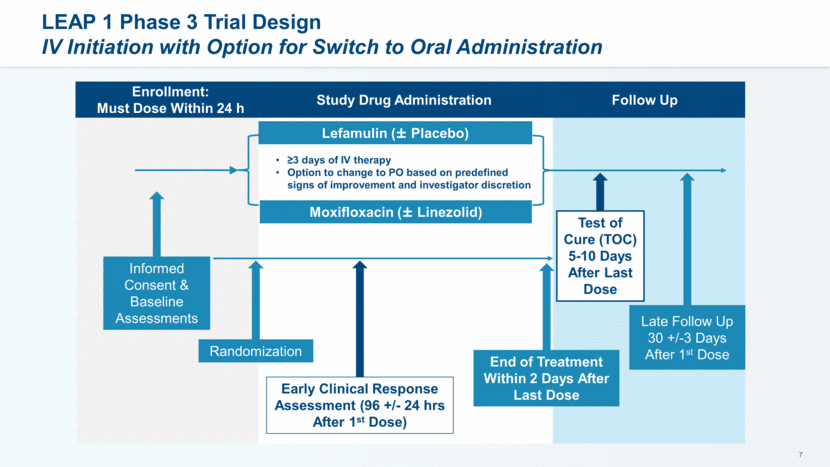
LEAP 1 Phase 3 Trial Design FDA and EMA Primary Endpoints At 72 to 120 hours after first dose of study drug: Improvement in > 2 of 4 CABP signs/symptoms No worsening in any CABP signs/symptoms Alive Did not receive non-study antibacterial therapy for the treatment of CABP Non-inferiority margin 12.5%, >90% power At 5-10 days after the last dose of study drug: Signs/symptoms of CABP have resolved/improved such that no additional antibacterial therapy is administered for the treatment of CABP Non-inferiority margin 10%, 80% power EMA Endpoints: Investigator Assessment of Clinical Response (IACR) at Test of Cure (TOC) mITT and CE-TOC Population FDA Endpoint: Early Clinical Response (ECR) ITT Population
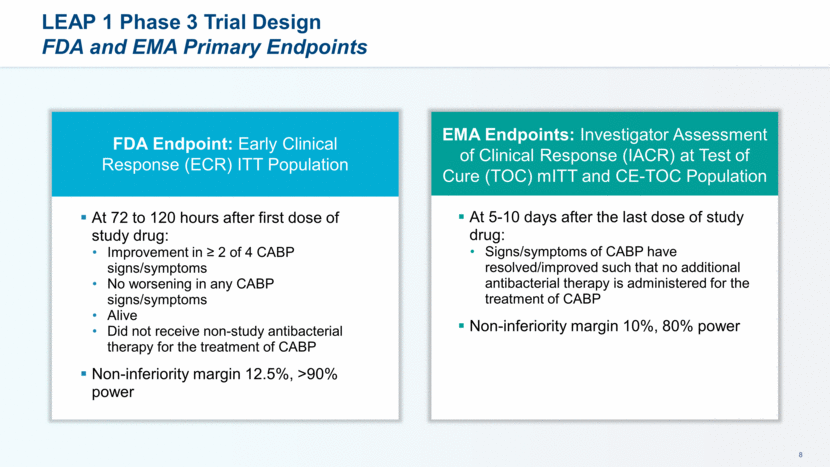
LEAP 1 Phase 3 Trial Design Symptom Assessment for ECR Symptom Absent (0) Mild (1) Moderate (2) Severe (3) Dyspnea Resolution (to pre-CABP baseline) or absence of dyspnea Dyspnea on exertion (e.g., climbing stairs) Dyspnea with normal/routine activities (e.g., walking) Dyspnea at rest or requiring oxygen therapy Cough Resolution (to pre-CABP baseline) or absence of cough Transient, does not interfere with normal activity Frequent, interferes with normal activity or sleep Constant, interferes with most or all activity or sleep Production of purulent sputum Resolution (to pre-CABP baseline) or absence of sputum production Sputum production rarely causes difficulty or distress Sputum production often causes difficulty or distress Constant difficulty with sputum production Chest pain Resolution or absence of chest pain related to CABP Transient, does not interfere with normal activity Frequent, interferes with normal activity or sleep Constant, interferes with most or all activity or sleep
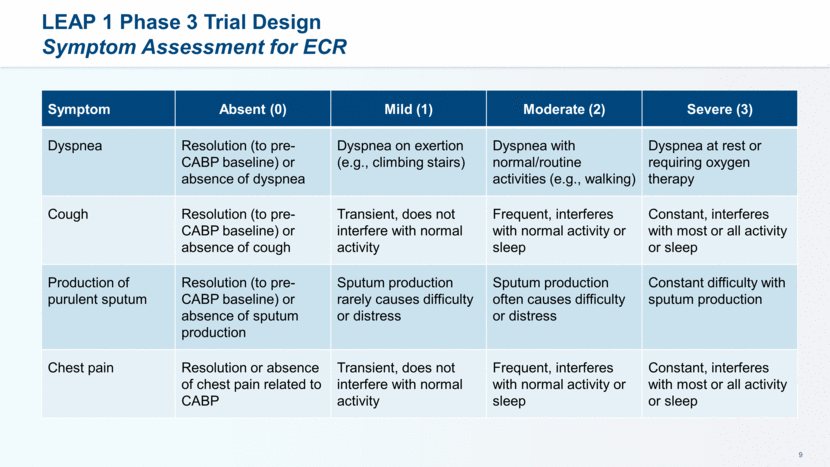
LEAP 1 Phase 3 Trial Populations and Disposition High Patient Completion and Microbiological Isolate Recovery Rates Category Lefamulin Moxifloxacin (±linezolid) TOTAL All Randomized 276 275 551 Modified ITT (mITT) 273 (98.9%) 273 (99.3%) 546 (99.1%) Clinically Evaluable-Test of Cure (CE-TOC) 236 (85.5%) 245 (89.1%) 481 (87.3%) Microbiological ITT (microITT) 160 (58.0%) 159 (57.8%) 319 (57.9%) Completed Study 249 (90.2%) 256 (93.1%) 505 (91.7%) Completed ECR Assessment 267 (96.7%) 261 (94.9%) 528 (95.8%) Completed TOC Assessment 260 (94.2%) 264 (96.0%) 524 (95.1%)
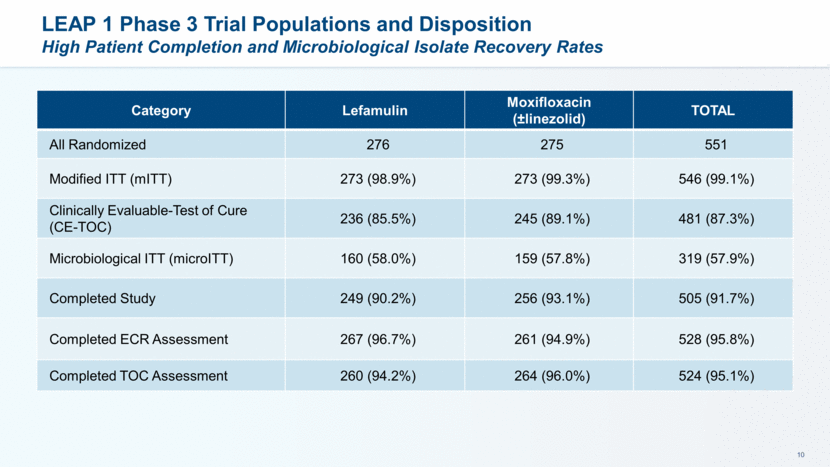
Category Lefamulin Moxifloxacin (±linezolid) TOTAL Age (Years; Mean) 61.0 59.6 60.3 <65 years 144 (52.2%) 167 (60.7%) 311 (56.4%) 65-74 74 (26.8%) 66 (24.0%) 140 (25.4%) >75 58 (21.0%) 42 (15.3%) 100 (18.1%) Gender Male 170 (61.6%) 160 (58.2%) 330 (59.9%) BMI (kg/m2) (Mean) 26.48 26.33 26.40 Race (White) 239 (86.6%) 239 (86.9%) 478 (86.8%) Renal Status Severe impairment (CrCl <30 ml/min) 3 (1.1%) 3 (1.1%) 6 (1.1%) Moderate impairment (CrCl 30-60 ml/min) 61 (22.1%) 62 (22.5%) 123 (22.3%) Mild impairment (CrCl 60-<90 ml/min) 89 (32.2%) 74 (26.9%) 163 (29.6%) Normal function (CrCl >90 ml/min) 121 (43.8%) 135 (49.1%) 256 (46.5%) LEAP 1 Phase 3 Trial ITT Population Balanced Demographics Between Treatment Groups
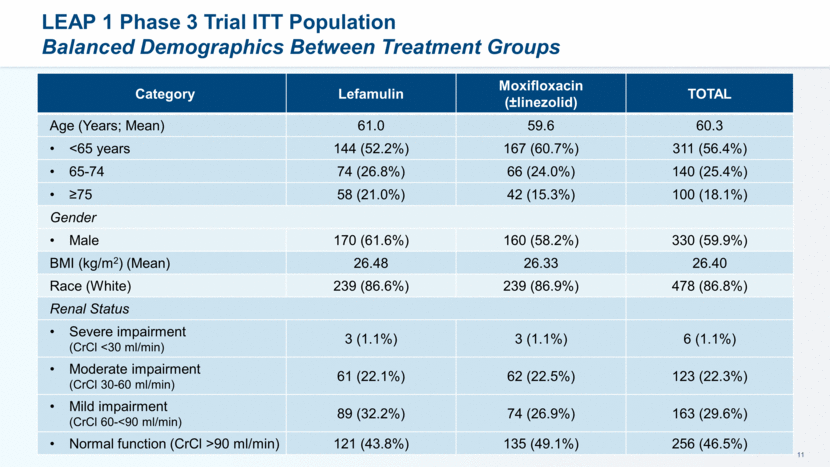
LEAP 1 Phase 3 Trial PORT Risk Classification: ITT Population Moderate to Severe Pneumonia Patients PORT Class Lefamulin Moxifloxacin (±linezolid) TOTAL II 0 1 (0.4%) 1 (0.2%) III 196 (71.0%) 201 (73.1%) 397 (72.1%) IV 76 (27.5%) 70 (25.5%) 146 (26.5%) V 4 (1.4%) 3 (1.1%) 7 (1.3%)
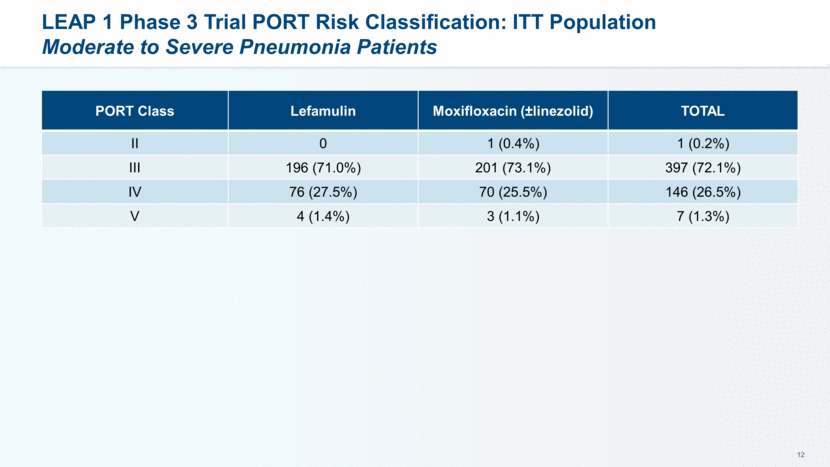
LEAP 1 Trial Efficacy Results
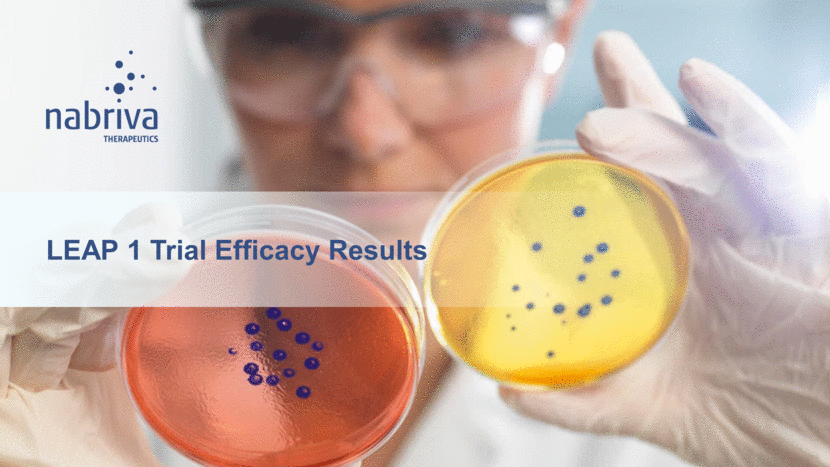
High Response Rates in Both Arms LEAP 1 Trial Efficacy Results Lefamulin Meets FDA Primary Endpoint of ECR Percent Responders Delta (95% CI) -2.9 (-8.5, 2.8) 0% 10% 20% 30% 40% 50% 60% 70% 80% 90% 100% ECR 87.3% 90.2% Lefamulin Moxifloxacin (±linezolid)
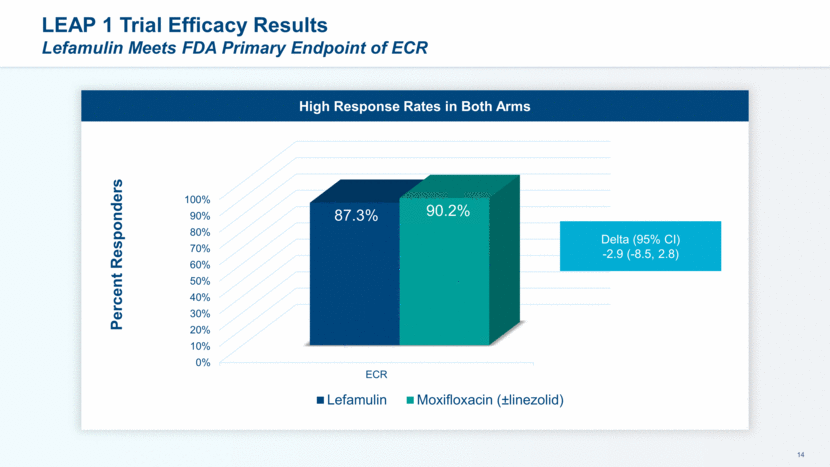
EMA Primary Endpoints: IACR in CE and mITT at TOC LEAP 1 Trial Efficacy Results Lefamulin Meets EMA Primary Endpoints Percent Responders Delta (95% CI) -2.5 (-8.4, 3.4) Delta (95% CI) -2.6 (-8.9, 3.9) 0% 20% 40% 60% 80% 100% IACR CE - TOC IACR mITT 86.9% 81.7% 89.4% 84.2% Lefamulin Moxifloxacin (±linezolid)
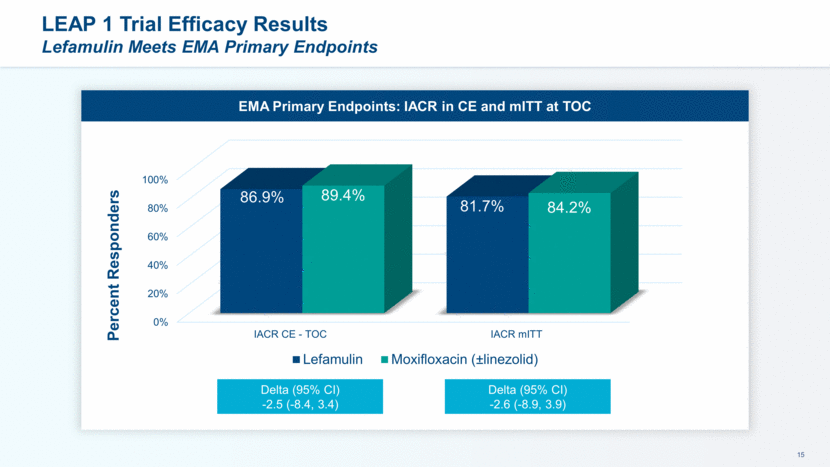
ECR by PORT Risk Classification: ITT Population Lefamulin Demonstrated High Response Rates Across All Severities of CABP PORT Class Lefamulin Moxifloxacin (±linezolid) Treatment Difference (95% CI) II 0 1/1 (100%) -- III 175/196 (89.3%) 187/201 (93.0%) -3.7 (-9.8, 2.3) IV 63/76 (82.9%) 57/70 (81.4%) 1.5 (-12.3, 15.3) V 3/4 (75%) 3/3 (100%) -25.0 (-96.6, 46.6)
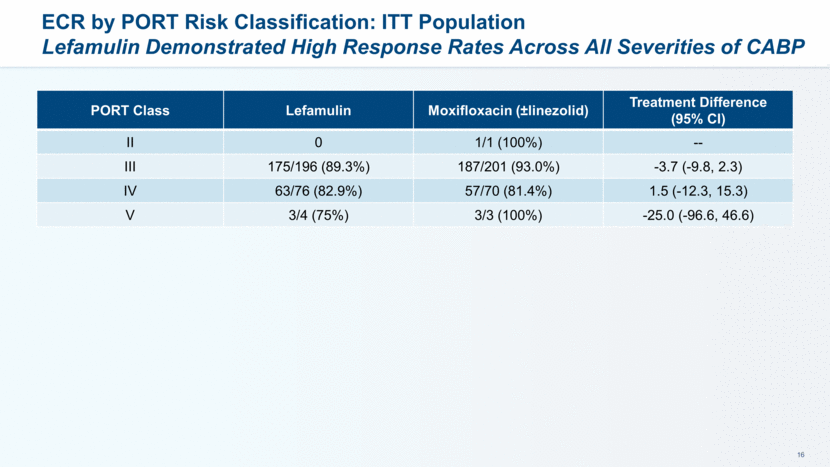
ECR by Baseline Pathogen – Typical Pathogens [micro ITT] Lefamulin Demonstrated High Response Rate Across All of the Most Common Causes of CABP Lefamulin Moxifloxacin (±linezolid) Microbiological ITT (microITT) N = 160 (58.0%) N = 159 (57.8%) Baseline Pathogen ECR (%) ECR (%) Gram Positive S. pneumoniae (SP) 82/93 88.2% 91/97 93.8% Penicillin-Susceptible SP (PSSP) 17/21 81.0% 16/18 88.9% Penicillin-Intermediate SP (PISP) 5/5 100% 2/2 100% Penicillin-Resistant SP (PRSP) 2/2 100% 2/3 66.7% Multi-Drug-Resistant SP (MDRSP) 6/6 100% 5/6 83.3% Macrolide-Resistant SP (MRSP) 6/6 100% 5/6 83.3% S. aureus 31/32 96.9% 13/13 100%
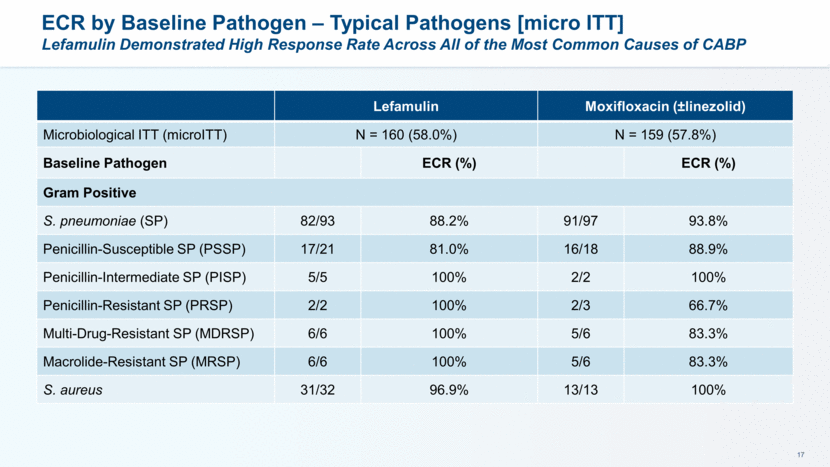
ECR by Baseline Pathogen – Typical and Atypical Pathogens [micro ITT] High Response Rate Seen Across All of the Most Common Causes of CABP Lefamulin Moxifloxacin (±linezolid) Baseline Pathogen ECR (%) ECR (%) Gram Negative H. influenzae 8/8 100% 6/7 85.7% M. catarrhalis 47/52 90.4% 52/55 94.5% Atypicals M. pneumoniae 16/19 84.2% 18/20 90.0% L. pneumophila 16/18 88.9% 12/14 85.7% C. pneumoniae 10/11 90.9% 18/19 94.7%
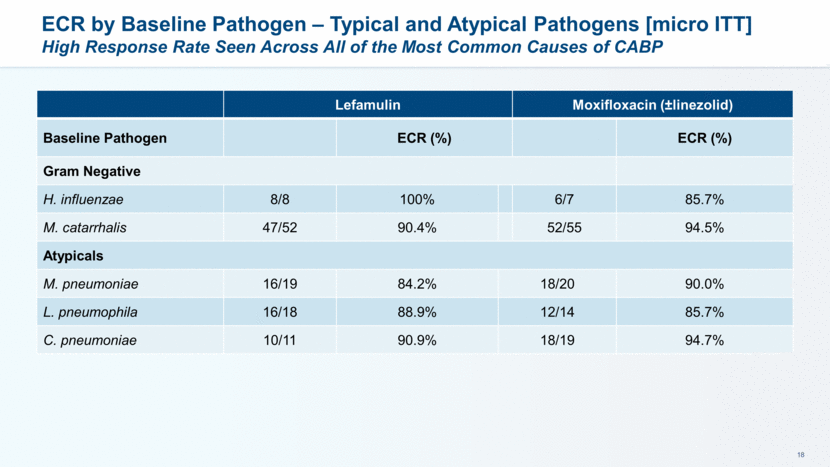
LEAP 1 Trial Safety and Tolerability Data
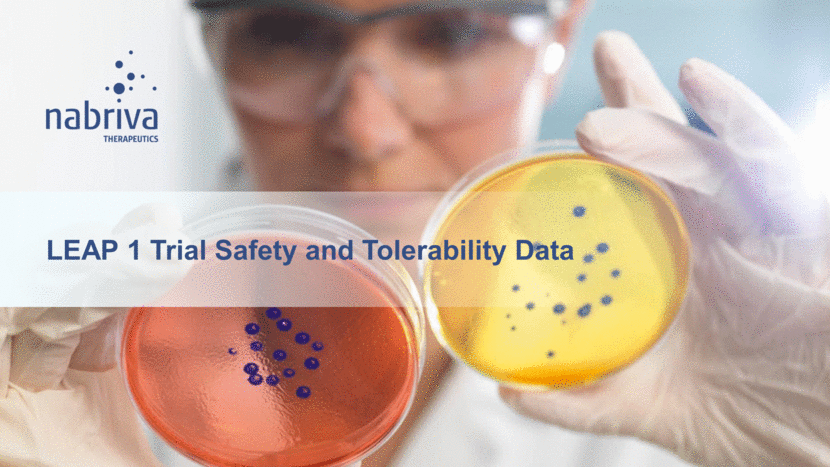
Overview of Adverse Events Low Rates of Discontinuation Observed Patients with at Least One Lefamulin (n=273) Moxifloxacin (±linezolid) (n=273) Adverse Events (AE) 105 (38.5%) 105 (38.5%) Treatment Emergent AE (TEAE) 104 (38.1%) 103 (37.7%) Serious AE (SAE) 19 (7.0%) 13 (4.8%) Related AE 41 (15.0%) 39 (14.3%) Related SAE 3 (1.1%) 1 (0.4%) AE Leading to Discontinuation of Study Drug 8 (2.9%) 12 (4.4%) AE Leading to Withdrawal from Study 5 (1.8%) 11 (4.0%) Deaths 6 (2.2%) 5 (1.8%)
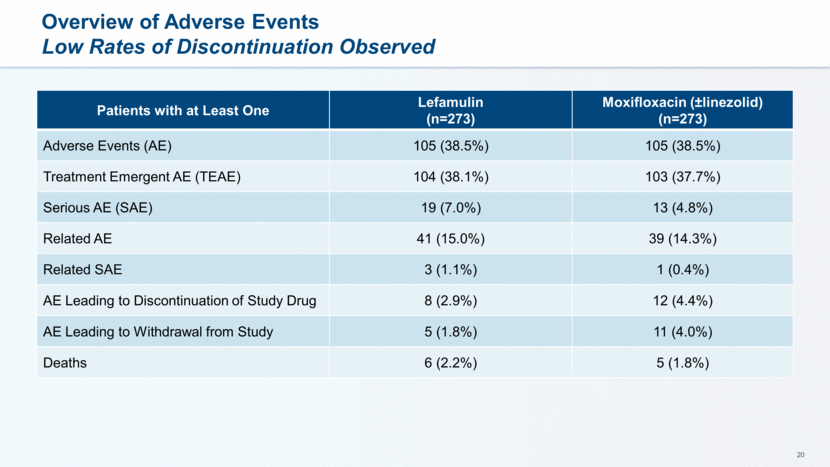
Treatment Emergent Adverse Events of Interest TEAEs in 6.6% and 13.0% of subjects receiving lefamulin and moxifloxacin (±linezolid), respectively No cases of Clostridium difficile infection were reported in either treatment group Diarrhea was observed in 0.7% and 7.7% of subjects receiving lefamulin and moxifloxacin (±linezolid), respectively TEAEs in 0.7% and 1.5% of subjects receiving lefamulin and moxifloxacin (±linezolid), respectively Gastrointestinal System Organ Class (SOC) Hepatobiliary SOC Cardiac Disorders SOC TEAEs in 2.9% and 4.0% of subjects receiving lefamulin and moxifloxacin (±linezolid), respectively
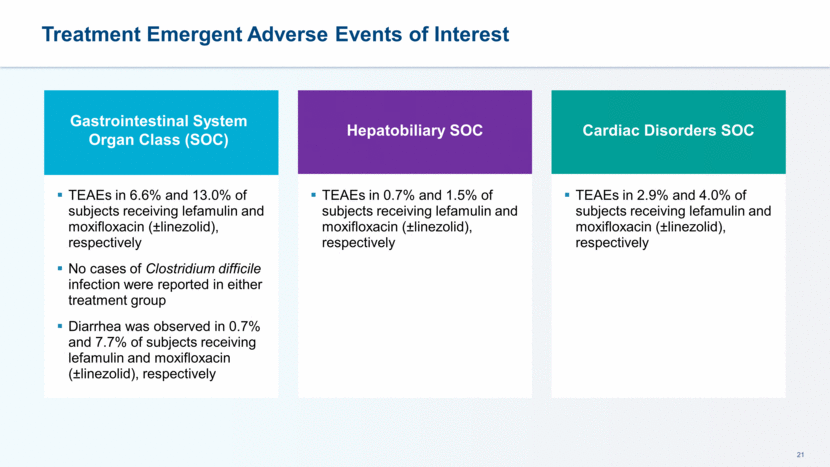
TEAEs > 2% for Study Medication: Safety Population Lefamulin was Well Tolerated with a Lower Incidence of Diarrhea Preferred Term Lefamulin (n=273) Moxifloxacin (±linezolid) (n=273) Hypokalemia 8 (2.9%) 6 (2.2%) Nausea 8 (2.9%) 6 (2.2%) Insomnia 8 (2.9%) 5 (1.8%) Infusion Site Pain 8 (2.9%) 0 (0.0%) Infusion Site Phlebitis 6 (2.2%) 3 (1.1%) ALT Increase 5 (1.8%) 6 (2.2%) Hypertension 2 (0.7%) 6 (2.2%) Diarrhea 2 (0.7%) 21 (7.7%)
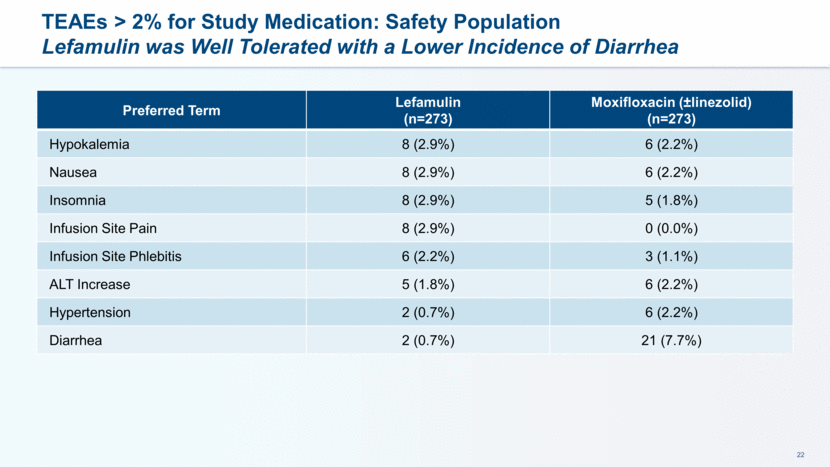
Maximum Post Baseline Liver Enzymes: Safety Population Low Incidence of Elevated Liver Function Tests Lab Parameter Lefamulin Moxifloxacin (±linezolid) Any Post Baseline ALT >3xULN 19/268 (7.1%) 17/267 (6.4%) >5xULN 6/268 (2.2%) 5/267 (1.9%) >10xULN 1/268 (0.4%) 0/267 (0.0%) Any Post Baseline AST >3xULN 11/268 (4.1%) 7/267 (2.6%) >5xULN 2/268 (0.7%) 2/267 (0.7%) >10xULN 1/268 (0.4%) 0/267 (0.0%) Any Post Baseline Total Bilirubin >1.5xULN 3/268 (1.1%) 3/267 (1.1%) >2xULN 0/268 (0.0%) 2/267 (0.7%) Any Post Baseline Alkaline Phosphatase >2xULN 5/268 (1.9%) 5/267 (1.9%) No subject met criteria for Hy’s Law
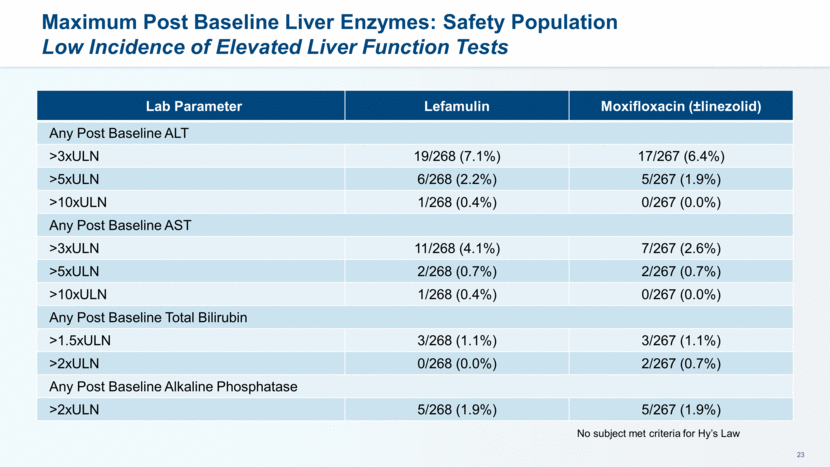
Maximum Post Dose QTcF Changes (Day 3) Parameter Lefamulin Moxifloxacin (±linezolid) Post Dose Increase 30 - 60 msec 12 (4.6%) 14 (5.4%) Post Dose Increase > 60 msec 0 (0.0%) 1 (0.4%) Post Dose Value > 500 msec 1 (0.4%) 1 (0.4%)
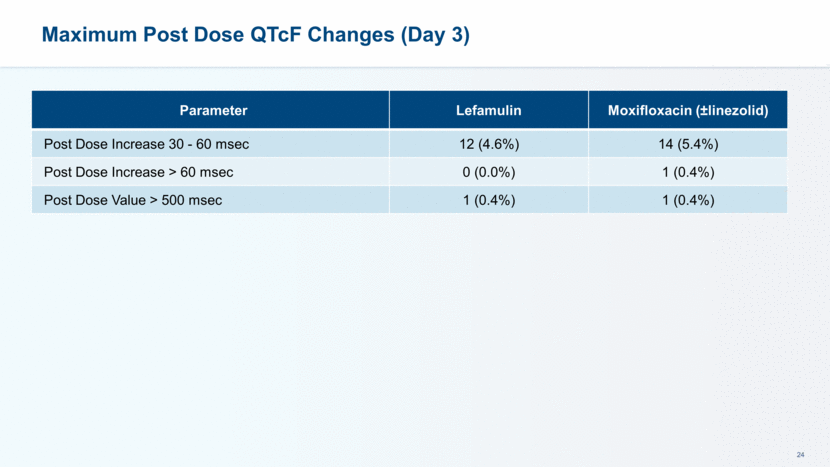
LEAP 1 Phase 3 Clinical Trial Highlights Lefamulin is the first anti-bacterial agent of a new class of antibiotics with favorable Phase 3 data in CABP in more than 15 years Lefamulin’s efficacy data - in our first trial treating adults with CABP - was comparable to a gold standard therapy Lefamulin showed a favorable tolerability profile with no unexpected safety signals or evidence of off-target effects Lefamulin IV, with an option to switch to oral administration, met all primary FDA and EMA endpoints of non-inferiority compared to moxifloxacin (±linezolid)
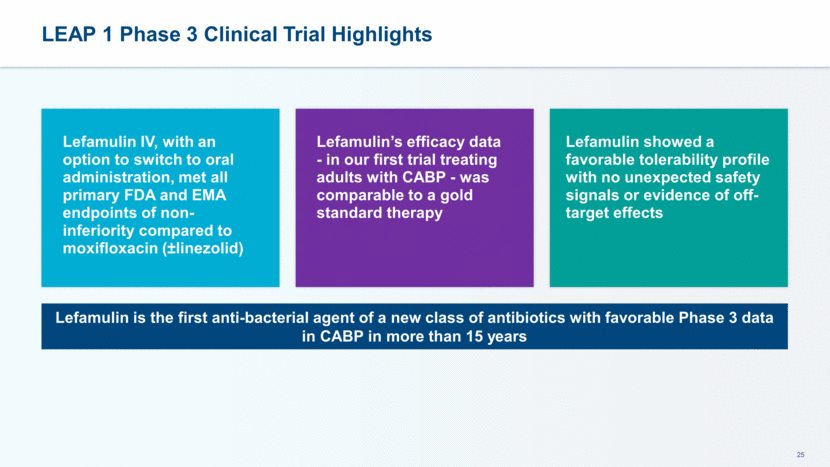
Acknowledgments Patients and families Clinical investigators and their staff Collaborating research organizations We are grateful for the participation and contributions of the following in the LEAP 1 trial: Thomas File, M.D. George Talbot, M.D. Anita Das, Ph. D. The Nabriva Therapeutics team
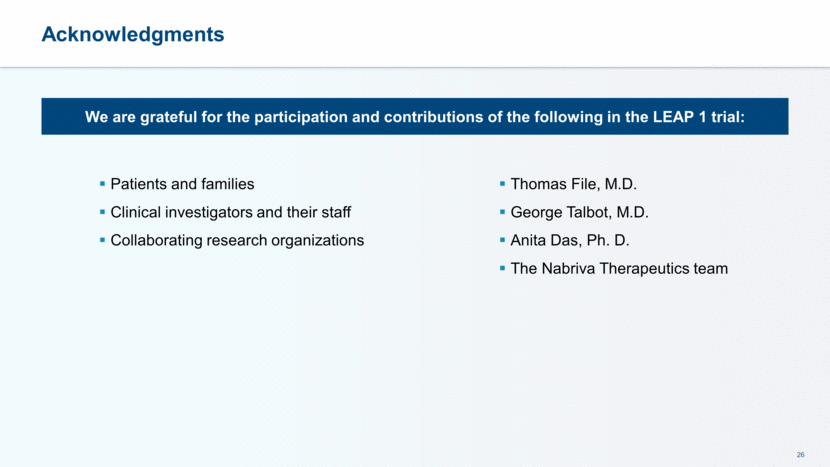
Lefamulin Addresses the Factors that Increasingly Influence Treatment Choices for CABP *10 days in clinical trials for confirmed MRSA CABP patients 5-7 days IV/PO Monotherapy for Most* Patients Novel Mechanism of Action CABP Targeted Spectrum of Activity Stewardship Guidelines recommend use of targeted antibiotics, not broad spectrum, and shortest effective treatment duration Resistance to many current antibiotics is rising and increases the need for antibiotics with novel mechanisms of action LEFAMULIN IV & Oral Formulations allow the flexibility to switch from any IV treatment and to discharge the patients earlier or avoid hospitalization
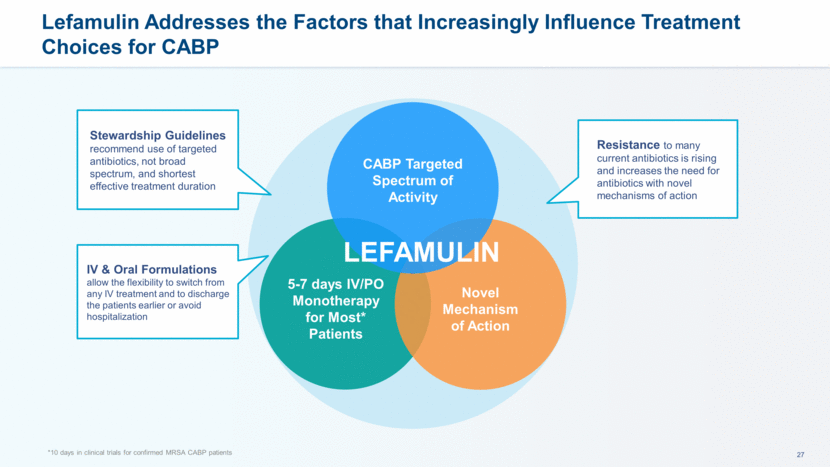
Feb 2017 Blinded, interim analysis to confirm LEAP 1 sample size Sept 2017 Topline data from LEAP 1 Phase 3 trial for CABP Anticipated Lefamulin Milestones Spring 2018 Topline data from LEAP 2 Phase 3 trial for CABP 2H 2018 Regulatory filing in US (priority review request to FDA) for CABP
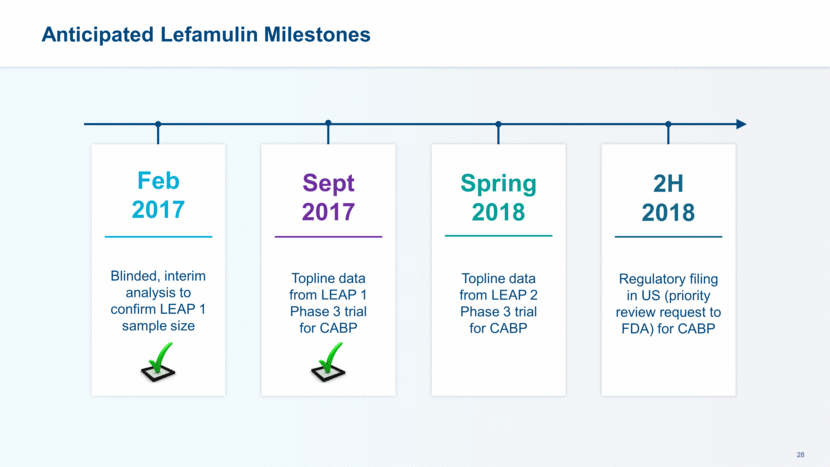
Lefamulin Evaluation Against Pneumonia (LEAP 1) Phase 3 Topline Results September 18, 2017

